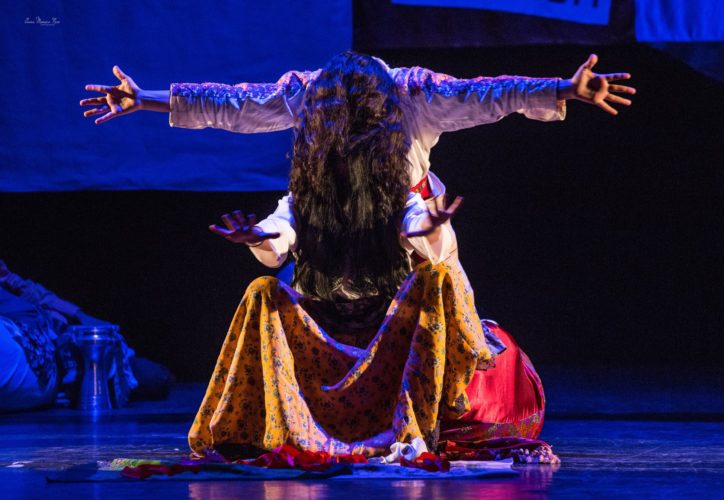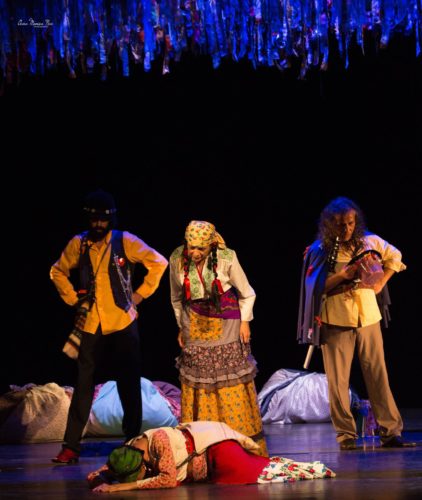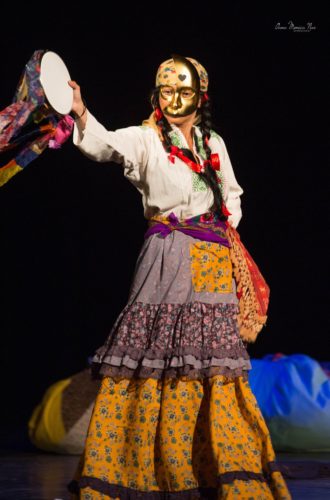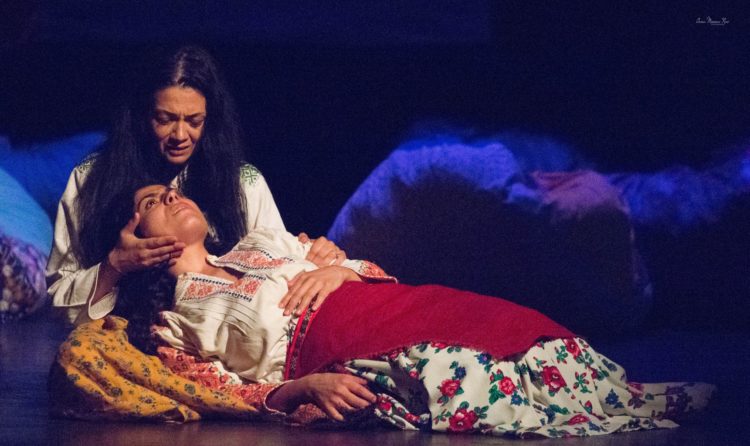July 10, 2018
By Valentina Iancu
The Witch as Instrument of Transgression

Kali Tras / Black Fear. Premiere: Jewish State Theatre, Bucharest. 6.06.2018. foto: Oana Monica Nae
I left the theater angry at myself for not having read enough, for not having looked around enough, for not having researched these histories that hang like a boulder from the answer to the question: “why is Romania different?” It is different because the largest ethnic minority in the country has come to internalize the racism with which the majority have labeled and progressively excluded them from national history. “They were de facto inferior for five centuries in one of the longest periods of slavery in the world, without a single moment of revolt recorded in historical archives. As a matter of fact, the term țigan [functionally equivalent nowadays to the English gypsy – tr.n.] denoted the social status of a slave, regardless of ethnicity.”[i] Slavery, pogroms, Holocaust, constant exclusion, stigmatization, exploitation, stereotypes. All unassumed. Unknown. And voices that could make a difference are still few in number, still unjustly isolated, still fighting for self-assertion more than any one of us.

Mihaela Drăgan and Zita Moldovan performing Kali Tras (Black Fear) at the Jewish State Theare in Bucharest.
The Roma actress power couple made up of Mihaela Drăgan and Zita Moldovan has established itself strongly on the local performance art scene in the last few years. The two are also the founders of the first female Roma theater company in the world: Giuvlipen (2014). Together, Mihaela and Ziţa have become a powerful voice on the contemporary scene, articulating emancipatory perspectives starting from the stories of Roma people in Romania with impeccable political coherence. “We want to offer an alternative to the way in which Roma people are portrayed in the media and in art (and the general public discourse). We make contemporary Roma theater and sometimes experiment in the area of performance art. Most of the time our shows talk about serious issues, for example racism or gender inequality, via comical mechanisms. We do a lot of critique via comedy and we generally avoid ‘teaching lessons,’” Mihaela told me in an earlier interview for Revista ARTA online.
I’ve been following them closely during their four years of activity in which they’ve created five production and, with their help, I started to understand who the “foreigner within” is, the person some of us continue to refuse to superiorly label with impunity as țigan. Roma identity goes hand in hand with the Romani language and must be understood through the lens of the racism that permanently barred Roma culture from any direction of development. Imagine the life of the minorities within the Roma minority! Countless hard-to-imagine tales were given voice in Giuvlipen’s shows. The most recent production, Kali Tras/ Frica neagră [Black Fear] stages the memory of the Roma Holocaust,[ii] a topic that is completely absent in contemporary Romania. Kali tras is one of the Romani expressions referring to the plans for the racial extermination of the Roma people during the Holocaust and can be translated word for word as “black fear.” The script is based on the novel of survivor Valerică Stănescu, Cu moartea-n ochi [“[looking] death in the eye” or “with death in the eyes/sight”], and on a long documentation process under the guidance of Roma historian Adrian Furtună (whose research is still essential to our knowledge of the history of the Roma Holocaust in Romania).

Kali Tras / Black Fear. Premiere: Jewish State Theatre, Bucharest. 6.06.2018. foto: Oana Monica Nae
The plot follows a nomad theater group from the beginning of the Romanian army’s hostilities to their being freed from the camps. Despite being full of humor and self-irony, there are times in the show when even closing your eyes won’t spare you from the sense of fear, shock, desperation. After each murder the room awakens from its dead silence, every moment of silence ends with a voice saying “Hai sus” [get up], like a liberating shamanic incantation. In fact the show’s atmosphere, scenery, costumes, and movement include elements from the symbolic vocabulary of magic practice. All are able to be rise from the dead, to satisfy their basic needs through autosuggestion and inner strength of mind and heart. They curse. They burn their theater and the owl’s curse comes true. The women are fortune tellers: the cowrie shells reveal to them the concentration camp and all the plights that await them in Transnistria. Exhausted with hunger, they dream of food. They revolt many times, and many die as a result. They curse Antonescu, the Nazis, and the Legionnaires. They invent songs in Romani to be freed from the “fascist yoke.” At the end of the war they leave a bit earlier, helped by a Roma Legionnaire to escape. Director Mihai Lukacs recuperates the traits of folk theater, characteristic of nomad Roma people, a politically justified and surprisingly theatrical intention.

Fortune teller. Kali Tras (Black Fear). Foto: Oana Monica Nae
Kali Tras is one of the most provocative shows about Roma identity. The fact that director Mihai Lukacs opts for the style of nomad/folk theater of exploring magic territories in surrealist fashion offers the show an immersive vividness that manages to always address the problem of exoticization. The viewer is seduced by the spells’ charm, surprised by the accuracy of cowry-shell divination, or deeply amused by the symbolic burning of the theater (partially non-existent physically) after the owl’s call. Is this reality? Difference, clearly signified by the usage of magic items, is sentenced to death and oblivion before our very eyes. Because the witch is the most feared figure in society: the independent woman that survives outside state systems, outside medical systems, in a universe where things happen according to different rules. For millennia only the witch has actively fought, on an individual level, against authority, both religious and secular. The term itself is very flexible. According to the DEX [Romanian language dictionary], a witch [vrăjitoare] is someone who casts spells [vrăji – like in English, it can also denote/connote “charming”], and spells are indefinable. It is a term that resists classification very well: the imaginary is infinite and definition impossible. Curator Anna Colin, one of the feminist researchers studying the figure of the witch, identifies three categories necessary for an understanding of the phenomenon: the witch as practitioner of magic, the witch that does not practice yet is identified by others as such, and the self-proclaimed, and also non-practicing, witch. In the case of Roma women, the second category is permanently present among the racist labels pinned on them. A still-relevant definition that liberates the figure of the witch from mythology and perfectly addresses the need of de-stigmatizing Roma witches and of freeing Roma women from this gratuitous label, is proposed in the French feminist magazine Sorcières (1975-1982): “the witch is the personification of female revolt, which, in defiance of contempt, oppression and persecution, says yes to herself instead of to the world as it was and is and should not be.”[iii] Identifying with the witch is a feminist political act, which is assumed courageously in Kali Tras.
We still operate nowadays within the imaginary constructs that were culturally encoded during the time of witch hunters (from which we believe we are centuries away, just because the attacks on witches in many contemporary African villages are ignored by the media). “There is no need, however (…) to decide whether Witch hunters truly believed in the charges which they leveled against their victims or cynically used them as instruments of social repression. If we consider the historical context in which the witch-hunt occurred, the gender and class of the accused and the effects of the persecution, then we must conclude that witch-hunting in Europe was an attack on women’s resistance to the spread of capitalist relations and the power that women had gained by virtue of their sexuality, their control over reproduction, and their ability to heal.”[iv] The Roma witch is a special figure in Romania, particularly in the Old Kingdom, where there wasn’t an actual witch hunt, but only a permanent demonizing that led to social exclusion. More recently, the media has managed to imprint into the Romanian collective imaginary the figure of the wealthy Roma witch, whose services are sought by politicians and various celebrities, and who is often caught in media scandals that often turn racist. Among Roma women they are just a minority. Conceptually too, in the broad category of witchhood, the fortune tellers [ghicitoare] and enchantresses [descântătoare] that appear in the media are just a minority.

Kali Tras / Black Fear. Premiere: Jewish State Theatre, Bucharest. 6.06.2018. foto: Oana Monica Nae
In the history of visual and performing arts, the figure of the witch is marginal and almost always included in art praxis by appropriating magical practices; this was first done by artists like Eleonora Carrington, Mary Wigman, and Marina Abramović. The witches in Kali Tras however don’t appropriate a practice, instead personifying a label, which is why including a magical act has the subversive and profoundly political role of contesting the exoticization and racialization of witches. Identifying with the witch as a symbol for the survival of social difference across the centuries is an act of transgressing stigmatization and of liberation through assumption. Because, as is stated in Kali Trasi states at the end, “our greatest curse is oblivion.”
Kali Tras (Frica neagră) premiered on 6 June 2018 at the State Jewish Theater.
Author and director: Mihai Lukacs
Writer: Mihaela Drăgan
Stage design: Iulia Toma
Choreography: Paul Dunca and Ana Costea
Cast: Mihaela Dragan, Zita Moldovan, Marcel Costea, Mircea Dragoman, Ninel Petrache.
Translation: Rareș Grozea.
[i] Ciprian Necula, Romi: de la robi la demnitate, Shukar magazine, no. 1/2018 [not translated into English].
[ii] I recommend Adrian Nicolae Furtună’s book De ce nu plâng?… Holocaustul romilor și povestea lor adevărată. Deportarea romilor în Transnistria: mărturii, studii, documente, 2012 [not translated into English].
[iii] Xaviere Gauthier, Temoignage sur l’experience de la revue Sorciere, in Anna Colin, Introduction, “Witches. Hunted, appropriated, empowered, queered,” edited by Anna Colin, p. 15.
[iv] Silvia Federici, Caliban şi Vrăjitoarea, Hecate 2016, p. 271 [in English: Caliban and the Witch, Autonomedia, 2009, p. 170]
POSTED BY
Valentina Iancu
Valentina Iancu (b. 1985) is a writer with studies in art history and image theory. Her practice is hybrid, research-based, divided between editorial, educational, curatorial or management activities ...




1 Comment
This is an informative and perceptive review. I wish I’d been in Romania to see the performances. One day.